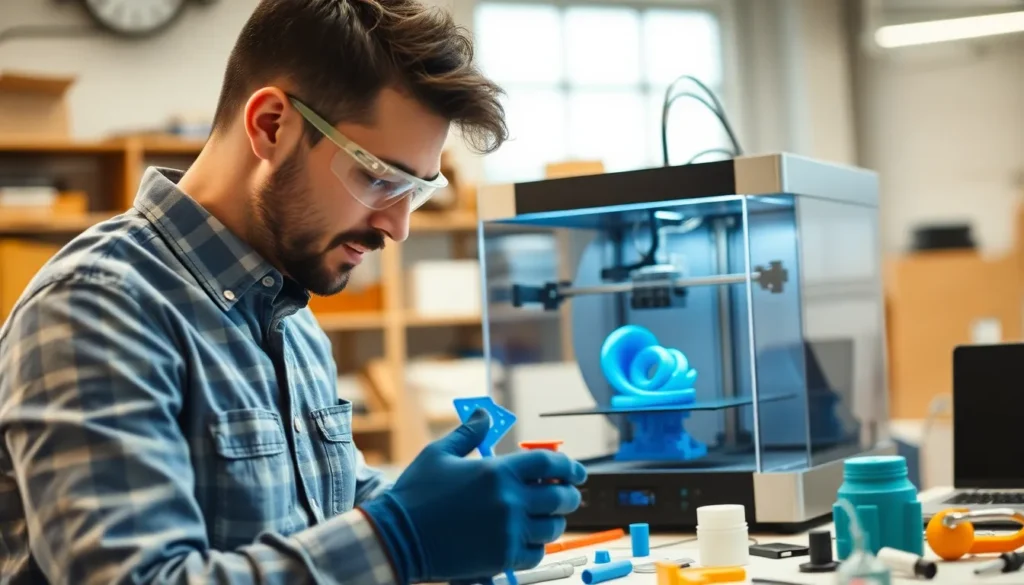Table of Contents
ToggleIn the world of 3D printing, resin printers are like the overachievers of the class—fast, precise, and always ready to impress. But there’s a catch: exposure times can make or break your print. Too little exposure, and your masterpiece turns into a gooey mess. Too much, and you might as well be casting a brick. It’s a delicate dance that requires the right rhythm to achieve stunning results.
Understanding resin printer exposure times isn’t just a technical necessity; it’s the secret sauce to elevating your prints from mediocre to magnificent. Whether you’re a hobbyist or a seasoned pro, mastering this art can save you time, materials, and the occasional heartache. So buckle up and get ready to dive into the fascinating world of exposure times—where every second counts and every print is a potential work of art.
Understanding Resin Printer Exposure Times
Resin printer exposure times play a critical role in 3D printing quality. These times determine how long light projects onto liquid resin during each layer curing.
What Are Resin Printer Exposure Times?
Resin printer exposure times refer to the duration that UV light illuminates resin to solidify layers. Every resin type requires specific exposure settings for optimal results. For instance, standard exposure times range from 6 to 15 seconds per layer, while some high-detail prints may need longer durations. Variations in printer models also influence exposure time settings. Understanding these nuances helps users achieve desired print quality.
Importance of Accurate Exposure Times
Accurate exposure times directly influence print quality and overall success. Insufficient exposure leads to incomplete curing, resulting in weak structures or failed prints. Overexposure can cause excessive curing, leading to brittle parts or distorted details. Finding the right balance maximizes the effectiveness of resin and contributes to a smooth printing process. Hobbyists and professionals alike benefit from precise timing, ensuring they make the most of their materials while achieving stunning prints.
Factors Affecting Exposure Times
Multiple elements influence the exposure times in resin 3D printing. Understanding these factors helps achieve optimal print quality.
Type of Resin
Different types of resin require varying exposure times. Standard exposure settings often apply to conventional resins, while specialized resins, such as flexible or tough options, need adjustments. For instance, flexible resins generally require longer exposure to ensure proper curing. Conversely, fast-curing resins demand shorter exposure times to avoid overexposure issues. Manufacturers usually provide specific recommendations, which serve as helpful starting points for users.
Layer Thickness
Layer thickness has a direct impact on the required exposure time. Thinner layers, ranging from 0.01 to 0.05 mm, often necessitate shorter exposure periods for each layer. Thicker layers, on the other hand, can tolerate longer exposures, typically between 10 to 15 seconds. While thicker layers may speed up the printing process, they risk sacrificing detail and surface finish quality. Adjusting the exposure time based on layer thickness enhances overall print resolution.
UV Light Source
The UV light source significantly affects exposure efficiency. Different printers utilize varied UV light sources such as LCD, DLP, or laser. LCD printers, for instance, often provide uniform light across the print area, resulting in consistent curing times. However, DLP printers can achieve more precise exposure due to their focused light source. Users must consider the specifics of their light source when determining the optimal exposure times for each print job. Variations in intensity directly relate to adjustments in exposure durations.
Optimizing Exposure Times
Optimizing exposure times enhances print quality and maximizes efficiency in resin 3D printing. Adjustments depend on various factors, including resin type and print settings.
Testing and Calibration
Testing exposure times ensures optimal results. Start by printing a small test model, which allows for easy adjustments. Use various exposure durations to identify the optimal time for solidification. Calibrate exposure settings based on the resin type and the specific printer model. Shorter exposure times might work better for certain resins, while others may need extended periods. Maintain a record of results for future reference, as this builds a reliable baseline for different projects.
Common Techniques for Adjustment
Common techniques for adjustment help refine exposure settings. First, adjust one factor at a time, focusing on layer thickness or exposure duration. Next, utilize a test pattern with varying intensity to determine the most effective combination. Incremental adjustments of 1 to 2 seconds can significantly impact print quality. Additionally, engaging with online communities can provide valuable insights into recommended settings. Observing the results of adjustments allows for fine-tuning, leading to enhanced print consistency and overall performance.
Troubleshooting Exposure Time Issues
Recognizing issues with exposure times is crucial in resin printing. Identifying the signs of underexposure and overexposure can help users achieve better print quality.
Signs of Underexposure
Weak structures often indicate underexposure during printing. Prints may appear tacky or have sticky surfaces, suggesting that layers haven’t fully cured. Additionally, insufficient detail in the final product can arise, with noticeable blurs or missed features. Failure to adhere to the build platform also signals underexposure, as parts may detach during the printing process. These signs require users to adjust exposure settings, increasing time to ensure proper curing.
Signs of Overexposure
Brittle parts typically result from overexposure in resin printing. Components may break or crumble under minimal pressure, indicating excess curing. Distorted details commonly appear on the surface, leading to loss of fine features that are vital for accurate prints. Parts may also develop excessive hardness, rendering them less flexible. Recognizing these signs facilitates users in reducing exposure durations to achieve a perfect balance between quality and durability.
Conclusion
Mastering exposure times is vital for anyone involved in resin 3D printing. Achieving the right balance between underexposure and overexposure can make all the difference in print quality and durability. By understanding the factors that influence exposure settings and regularly testing and calibrating, users can enhance their printing results significantly.
Engaging with the community and sharing experiences can also lead to valuable insights. Ultimately, taking the time to refine exposure times not only improves the quality of prints but also maximizes resource efficiency, making it an essential skill for both hobbyists and professionals alike.




